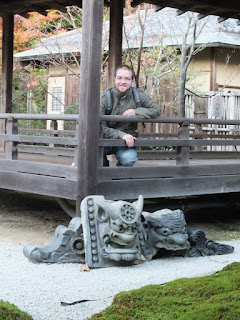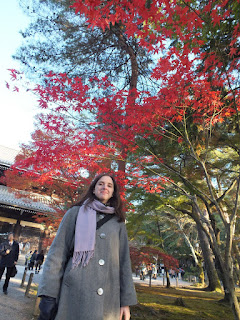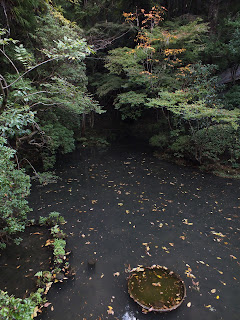Eikan-do, the more northerly of the two, came first. The temple has three claims to fame: an iconic hillside pagoda, some spectacular gardens, and a statue of a backwards-looking Amida Buddha. (A bit less of a draw these days.)
As with many of the temples we visited on this trip, Nana and I spent a lot of time just wandering - these big temples have a lot of pretty little nooks and crannies to explore. I think our favorite spot was an enclosed courtyard in the old abbot's house, filled with a swampy little koi pond and some brilliant red and yellow trees.
We sat down here to wait out a brief rain shower, but ended up staying quite a while, as the considerable crowds drifted quietly by. A whole ten minutes, at least, were spent marvelling at a strange little freshwater crab that seemed to be common in those parts.
After a time, we started up the hill to the pagoda, where we'd been told to expect a nice view of the eastern part of the city.
Alas, I couldn't seem to find a good angle on the pagoda itself, one of the classic Kyoto sights.
In addition to all this, Eikan-do is also known for its diverse architecture. The aforementioned pagoda, accented in red, blends Chinese and Japanese elements. Other parts of the temple are classically Japanese, all dark wood and white walls with occasional touches of gold.
While still other parts of the temple look almost Korean, exploding with vibrant colors.
____________
We wrapped up the following day at nearby Nanzen-ji, the head temple of the Rinzai Zen branch of the same name. While Eikan-do feels very much like a temple, Nanzen-ji feels more like a park, with buildings and sub-temples dotting its wooded expanse.
At the front of the temple is a huge ceremonial gate half-hidden by trees. For a small fee, you can climb to the second-floor balcony, which is a rare treat - most of the time, you're stuck staring up at these things from below.
 |
| Nana thought that tree looked suspicious. |
At the back of the temple is the abbot's house and its famous Leaping Tiger Garden.
 |
| Strangest-looking HoJo's I've ever seen. |
 |
| Not pictured: leaping tigers. |
It does mean your feet get pretty chilly by the end of the day.
After exploring the abbot's house, Nana and I headed uphill, so a noted sub-temple and its little garden on the southern edge of the complex.
On the way, an eerie sight: a 19th-century aqueduct, casting a gloomy shadow over the trees.
I can't tell you if it's still in use, but the water is still running. There are even some fish in there, and at least one patient heron perched on the ledge.
The sub-temple garden itself was a fine spot to rest our legs for a bit at the end of the day.
 |
| Nana in quiet, totally un-ironic contemplation. |
EDIT: I've just noticed that I described Nanzen-ji out of order - we went up the hill first, then to the abbot's house. But I'm much too lazy, and photos in Blogger are much too unwieldy, so please forgive me for leaving the post as it is.








































































